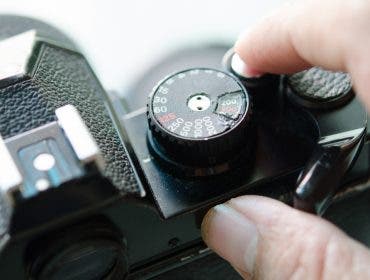Why spend $10,000 for the Pentax 645D medium-format camera when you can get a higher-resolution 35mm-format DSLR for thousands less? Hint: It’s not about resolution!

Let me start this Pentax 645D review off with a simple statement: Most of you reading this will never buy or need a Pentax 645D, or any medium format digital camera for that matter. Cameras like this, or the Mamiya 645DF, Hasselblad H4D and Leica S2 as well as many others that can be adapted with PhaseOne or Leaf backs with resolutions of between 22 and 60MP, are far more camera than what most folks need.

America’s Next Top Model Finalist Allison Harvard, shot with the Pentax 645D and Pentax SMC-DAF 55mm f/2.8 lens. Below: Amazing detail in 100% enlargement.

The Medium Format “Look”
However, for the very discerning professional, it’s not only about resolution. There is a “look” to Medium Format that cannot be achieved easily with a 35mm full-frame camera, and certainly not with an APS-C camera. This look is due to the fact that the larger sensor (and in the old days film size) requires longer focal lengths and image circles to achieve the same field of view as a 35mm based system. This leads to a shallower depth of field than 35mm-based and APS-based systems. For instance the 75mm f/2.8 Penatx FA lens that is the 645D’s normal will have far shallower depth of field than, say, a Canon 50/1.2L when focused on a subject at say 10 feet to match the field of view at the same aperture. Sure, a Canon 1DS Mark III or the newly announced Nikon D800 definitely match many Medium Format systems in resolution, but they definitely will not have that Medium Format “look.”
Another advantage to most Medium Format systems, much like their film-based forbears, is the ability to crop into an image and still have a fairly high-detailed file. (See the above shot of Allison Harvard’s eyes. There is so much detail that you can see every hair in her eyelashes—and that her eyes are bloodshot!) Granted, today’s full-frame 35mm based systems have resolution enough to match this, but with Medium Format’s larger sensors and therefore larger photosites, they tend to retain better fine detail in such crops.
The downside to medium format? Many features most have grown used to on 35mm-based systems simply do not exist on digital medium format cameras. Movie Mode? Keep dreaming. You will not find fast shooting, super-fast glass, or any of the many other technological whiz-bang features. All of these systems are bare-bones, pure photographic tools, with emphasis on “tool.”
In this review I will compare how the Pentax 645D compares to other Medium Format systems. Don’t expect side-by-side comparisons to 35mm systems, but more what the experience is like with this tool.

In The Hands
The first thing one notices is that the 645D is unlike any other Medium Format Digital Single-Lens Reflex (MFDSLR) camera currently in production. While other systems are usually adaptations of old film bodies to digital technology, the 645D is a ground-up digital reinvention of the old 645N II. While it may look like your old film camera, it certainly is not. For instance, I own an old Contax 645. When using a digital back I have to deal with two sets of controls that take some getting used to and are not a smooth marriage.

The Pentax 645D, on the other hand, is definitely a fully digital beast. It only looks like your old film camera. Bristling with 19 separate controls, almost any parameter can be modified without ever having to get into the menus. The only other MFDSLR I can think of that is this well integrated is the Leica S2, another “from the ground up” purely digital camera. While having that many control points sounds daunting, in actual operation the controls are so well laid out, they never really got in the way. Most buttons or knobs only control one parameter, making adjusting the camera to various shooting conditions quite simple, almost second nature. As a testament to the simplicity of use, the review unit I received had no manual, yet within 5 minutes I could easily control the three most important parameters on the camera—aperture, shutter and ISO sensitivity.
Another surprise that comes from the complete reinvention is the 645D’s AF system. Unlike every other MFDSLR, the Pentax 645D has 11 cross type AF points. While the top of the line Canons and Nikons may have more, for MFDSLRs Pentax is king of the hill in this regard. No other MFDSLR has as advanced an AF system. The selection between the three separate AF modes is handled by one of the dedicated 19 control switches on the 645D.
Overall, the 645D’s handling is far better than any of the digital backs I have used, providing all the most important controls directly to the touch. Want to adjust bracketing? There is a dedicated button for that. Want to switch between which memory card you are shooting to? There is a dedicated button for that. Want to quickly switch from shooting RAW to JPEG or vice versa? There is a dedicated button for that as well, and it’s even configurable between JPEG, RAW+JPEG and RAW dependent on what your preferred shooting style is.
Metering mode? Separate dial switch for that as well as Mirror Lock up, Configurable X-Sync switch, White Balance and White Balance Shift on separate controls and even an additional “Green Button” that can configured to your heart’s desire. All it lacks is a switch so I can automatically place my order to Starbuck’s so I can quickly send my assistant to just pick up my coffee without any fuss!

Fashion Week Portrait of Shail Upadhya shot as JPG. Pentax 645D and Pentax SMC-DAF 55mm f/2.8 lens.. 100% detail below.

About the only point where the 645D is at a disadvantage is support with the major tethered shooting software Capture One Pro. While Capture One does provide RAW conversion abilities when shooting DNG, it does not natively allow direct capture and control of the camera. While there are workarounds, including using Eye-Fi cards and the recently announced tethering software from Pentax that will be available in March, until Capture One announces support for this camera, tethered shooting workflow will be a weak point.
That said, the handling and operation of the 645D is light years ahead of any other MFDSLRs as Pentax has taken advantage of what it has learned with it’s top line APS-C DSLRs and applied it here. The camera is a joy to operate with sensible menu structure similar to that found in other Pentax products. The camera just does not get in the way of shooting most of the time, which is as it should be. Pentax has taken the approach of “Photographic Tool First, technological marvel second” which I think many photographers will appreciate. No nonsense, nothing in your way shooting so you can concentrate on just that, shooting.
In the Cards
About the only weak point here is the aforementioned tethering support. You must rely solely on SD Cards. The 645D has dual SD slots, which is good. On a 16GB card one can get about 650 shots. In DNG this drops to about 170. The weak point here is the fact that 645D does not understand or take advantage of accelerated cards. I used both AData 16GB Class 10 SD Cards and SanDisk 16GB Extreme Pro 95mb/sec UHS-I Cards and it still took roughly 10 seconds to write a photo to the card whether JPG or DNG. To mitigate this a bit the 645D’s buffer took under shooting conditions that I used it under about 7 shots DNG and around 11 shots JPG in the buffer and as soon as a shot cleared allowed you to shoot again.
Now while shooting landscapes and the Portraits outside of Lincoln Center this was not much of an issue, but when used on assignment backstage and for WWD where one fires a slight bit more, this became a very real nuisance. The issue again reared itself while in studio as well. I had to slow down a bit or, as I ended up doing, taking a few more breaks to allow the camera to catch up. Though to be fair, no MFDSLR that accepts memory cards that I have used can be described as quick in this regard, why the vast majority of times these units are tethered. Hopefully Pentax will address this issue via firmware to allow faster clearing of the buffer.

Faye Brandt Shot in DNG. Pentax 645D Pentax 67 165mm f/2.8 Takumar, available in the Adorama Used department via Adpater.
Image Quality
So now that all the operational aspects have been discussed, how is the Pentax 645D’s image quality? At this level of photography there is no such thing as a bad camera to be honest, and what really differentiates the various models is so miniscule one would be hard pressed to find a serious fault. The 645D is no exception. The image quality is excellent—on par with any other MFDSLR currently on the market.
Compared to full-frame DSLRs, the quality is mind bogglingly far ahead of any 35mm based system. The level of sheer resolving power of this large sensor without an AA filter easily out performs the quality I get from my Canon 1Ds Mark III with L glass.
Why Medium Format Lenses MUST Have Better Resolution
For the most part, Medium Format lenses are designed to resolve very fine detail well, and while there are differences between a Zeiss 80mm f/2.8 and say a Pentax 645 75mm f/2.8 (for example), they are really more to the “draw” of the lens than anything else. What is fantastic with the Pentax 645D in this regard is that the AF system will provide focus confirmation with the vast family of older manual focus lenses that were designed for the original Pentax 645 if you love the draw of the older Takumar optics, as I do.
This also extends to shooting with my preferred Medium Format lenses—the old 70’s Pentax 67 Takumars via the 67 to 645 adapter Pentax made. The 67 lenses can be shot using the focus confirmation and will be automatically stopped down by the 645D, though the adapter does not transmit to the metering system the aperture value of the lens mounted. You will need to just use a handheld meter. The amazing resolving power of these 67 lenses allow you to really see the detail one can achieve with a system of this nature as shown in the shot below.

Leica M4 Product Shot. Pentax 645D with Pentax 67 135mm f/4 Macro Takumar via Adapter.
That feature is a real attraction for me: I still have my old Pentax 67 system, and found using these lenses again with the modern benefits that the 645D provided was a very powerful combination. Pentax has promised to reintroduce all the old 645N AF lenses back into the market, and I hope they reintroduce this adapter as well.
Speaking of lenses, I think it is fantastic that Pentax does provide focus confirmation as currently the only in production lenses are the 25/4 and 55/2.8, and older AF lenses are becoming quite scarce on the used market. The older manual focus lenses are available at the Adorama Used department at reasonable prices.

Andy Glady, Adorama used department. Pentax 645D with Pentax 45mm f/2.8 SMC-FA lens at ISO 1600.
The high ISO performance is on par with most modern DSLRs, which for the most part puts it ahead of the vast majority of other MFDSLRs that are now on the market. Where this comes in handy is when shooting JPEGs. The JPEG engine on the 645D is quite good, producing very detailed images with little chroma noise at all ISOs up to 1600, with 3200 showing just a tiny bit. The native settings are a little on the low contrast side at ISOs above 400, much like color negative film. The JPGs can be adjusted somewhat in post, though obviously shooting in DNG format gives far more control and flexibility.

Theater Lab Director Orietta Crispino. Pentax 645D and Pentax SMC-DAF 55mm f/2.8 lens..
Color response is typical Pentax: Quite good, with the possible exception of the Tungsten setting that tends to be a bit too aggressive creating a slight blue cast. In these situations I highly recommend either shooting a white card or dialing in a direct Kelvin reading. Again at this level this is a minor quibble as most users will either shoot a target or dial in a direct Kelvin reading anyway. Where it does affect one is when shooting JPG as I did for WWD. In this situation there is a complete image adjustment menu that lets one adjust and prep the JPG engine to provide the output desired. Like other Pentax DSLRs there is a complete on board RAW converter so you can quickly generate a JPG if needed on the spot and even save it to the other card. Another trick is the last image shot can be resaved as a RAW file directly from image review.

American Ballet Theater Ballerina Zhongjing Fang. Pentax 645D and Pentax SMC-DAF 55mm f/2.8 lens.. Below: 100% detail of hat.

Conclusion and Recommendation
How good is the Pentax 645D? This camera represents an amazing value in the Medium Format Digital sector. The Image Quality is on par with similar models from Leica and Phase One, and with it’s plethora of available lenses a system that hits the ground running. Its modern controls are a refreshing change from the uneasy truce that most digital backs provide.
Being a photographer who loves the look of Medium Format, I would take this over the current top of the line Canon or Nikon. Sure, the new Nikon D800, Canon 1Ds Mark III, and other 20+mp 35mm based systems will give you this level of resolution, but they won’t provide that Medium Format look. I miss that look, and now for just a (relatively) small investment I can enjoy it again. If you are looking at D4, D800 or other top-line DSLR and don’t need or care about video, I would highly recommend you look at this system. There is nothing like Medium Format and now that there is an affordable (relative to other MF systems) option there is no excuse to not own one. Even with the limitations, I love this camera. I can’t wait to shoot it again.


